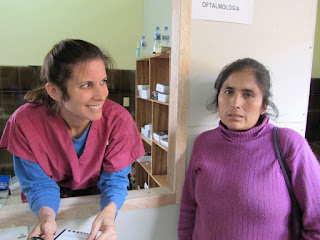 |
| Lisa, queen of the eye clinic. photo by Marie Hasnain |
When we arrived at the clinic this morning it was immediately apparent that this might be a more mellow day than the previous two. Perhaps the people here know that the earlier they come to the clinic the better as the supply of medicines in the pharmacy is more likely to be slimmer by the final day. All the doctors had a comparatively abbreviated list of patients and the two Peruvian doctors worked in the pharmacy because we were told by one of the nuns that the people were only interested in seeing American doctors. With the two of them there to work as interpreters I was not needed in the pharmacy and my cousin would be spending the morning interpreting for my aunt. So when we received word that an interpreter was greatly needed in our eye clinic downstairs, I immediately ran down and threw myself into something new. Lisa, one of the volunteers in our group, had collected hundreds of pairs of reading glasses, sunglasses and prescription glasses (the latter we will leave for an opthamologist who will be visiting the Policlinico Belen in November since no one in our group can claim that specialty).
 |
| Sabrina testing for reading glasses. photo by Rosa Ten |
When I arrived at the eye clinic Lisa handed me a test-card and I immediately began to address the people standing in line at our window station: "Hasta donde se puede leer . . . what line can you read to?" I would ask each person, and fit them with reading glasses accordingly until they came within a normal range of vision. I realized that the glasses would probably be most valuable not for reading--Peru has the second highest illiteracy rate in South America, just behind Bolivia--but for those people who depend on their eyes for work, i.e. women who sew or weave all day. I recognized some of the people who didn't know how to read, so I would sometimes ask "what line is
clear for you?"
 |
| "Can I have the brown ones?" photo by Rosa Ten |
After experiencing both the pharmacy and doctor/patient translations in the examination room I was surprised by my experience in the eye clinic. While not the most challenging use of my language skills, it was certainly the most frustrating job at the clinic. There was a distinct contrast between those who actually needed the eyeglasses and those who just came to get free stuff. I was astonished by how choosey many people were. Perhaps in the pharmacy they were simply given what they needed and so here in the eye clinic they felt more of an opportunity to "shop" for what they wanted. A handful of times a person I tested presented perfect vision but when I told them their eyes were fine and they did not need glasses they asked to see the reading card again and suddenly their vision had changed. I had to refuse a number of people, explaining to them that if we gave them glasses when they didn't need them it could actually do more damage than good for their eyes. When I did match someone who needed glasses with a correct pair, I was almost always confronted with "mamiiiiita, I don't like the red ones, can I have brown ones?". . ."aaaay mamiiiiiita, por favooooor." I continually had to tell people "what's important is that it works for your eyes, not what it looks like on your face." Those of us working in the eye clinic this morning joked about those moments in which we lost our "charitable feel." The sunglasses were particularly frustrating to give out because some of the people asking for them were clearly not those who might need them the most. A group of young women with cell phones wanted to try on several different pairs in the attempt to find the most hip style. A middle aged woman came to our window a total of four separate visits, each time wanting to trade a pair of sunglasses she had already been given, as well as a pair that had been given to her husband (I had matched him with a nice pair that suited him well, but she continued to fuss until finally she was satisfied with a pair she chose for him that happened to be womens' sunglasses . . . but of course were wore not about to mention it!)
 |
| Lisa testing for reading glasses. photo by Claudia Paya |
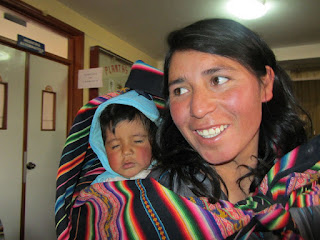 |
| My Quechua interpreter. photo by Marie Hasnain |
Despite these scenarios of more involved customer service, we
definitely were able to help the people that truly needed it. There were plenty of interactions I had throughout the morning that made up for any of the others. Each time I placed a pair of readers on someone there was a moment of anticipation. Some became instantly so delighted and grateful . . . to watch the expression on someone's face as they can suddenly see clearly again ("you gave me my eyes back!") was both exciting and endearing. I particularly enjoyed matching a person to a particular style of sunglasses based on their size, age, shape of their face, etc. I matched older men with aviators and mamitas with various styles that made them feel muy guapa. At one point I attended to the old neighbor couple from across the street whom we had met last night and set them each up with a pair of readers and sunglasses. Several times I had to recruit a Quechua translator from the crowd at the window to help me with a person who did not speak Spanish. One ancient mamita pulled me in close and planted kisses all over my face when I placed a pair of big dark wraparound shades over her eyes. I pictured some of these people going about their daily work tending the potato and maize fields high in the mountains under the intense Andean sun and sporting their new sunglasses!
 |
| A stylin' mamita. photo by Rosa Ten |
 |
| photo by JG |
There are such major issues with eyes and obstructed vision here . . . so many older folks have visibly clouded vision, cataracts, glaucoma, blinding . . . I hope that this simplest act of wearing sunglasses can help some of them protect their eyes from sun damage at least for a little while longer. I melted inside each time I placed a pair of readers or sunglasses on a sweet little mamita with her tophat. Something about the traditional clothing and hat together with the modern shades was so very endearing. The intimacy of gently placing glasses on someone's face, then looking into their eyes to see their twinkle of delight, excitement and wonder made my morning in the eye clinic truly memorable.
 |
| Michelle matching a woman with sunglasses. photo by Marie Hasnain |
After lunch I was again positioned to translate for my aunt. This doctor/patient interaction is certainly the most challenging for my language skills because I don't know what to expect and I must be creative with my use of words so that the patient can relate to what I am saying (for example, in explaining to a mother how to brush her small child's teeth, I told her to use a squeeze of toothpaste about the same size as a "semilla de maiz"--a corn kernel). This afternoon however, I was feeling much more confident in translating for my aunt in the examination room, often anticipating what she would want to ask of the patient and knowing the right questions to explore without her needing to prompt me as much. It was so special for me to work beside her, to see her do what she does so very well, to appreciate her hands-on care and gentle style of doctoring.
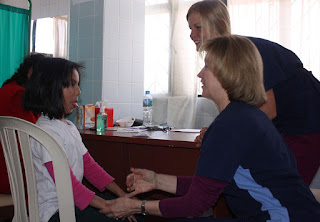 |
| Translating for my aunt, Dr. Katherine. photo by Alison Nichol |
Throughout the afternoon and into the evening we attended to a number of patients. One girl of 16 presented a strong case of asthma and chronic allergies that had affected her since as far back as she can remember. A 40 year old man with a large burn scar on one arm was concerned about an intense and persistent pain in his right leg and a lump on his hip. He looked embarrassed when we asked him to take his pants off so my aunt could examine his leg. We provided reassurance to a grandmother in two consecutive consultations--first her grandson, then her granddaughter--that the children are perfectly normal and healthy. "He's too small, he gets cold so easily, his skin is pale," she said of the boy, and of her granddaughter: "she is too small, she doesn't eat enough." Dr. Katherine asked the grandmother and granddaughter to stand beside each other and explained that if the parents are small, typically the children won't grow very tall either. We gave them each some vitamins and the grandma left reassured that all is well. We saw a young woman with a visible swelling in her cheek
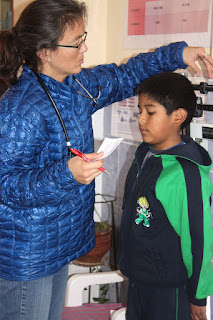 |
| Dr. Teresa checking a young patient. photo by Alison Nichol |
due to infection. A young expecting mother worried about how this pregnancy was causing more pain and her belly is hanging much lower than in her other two previous pregnancies. A mamita told us of intense pain and discharge when urinating and of her fears because others in her village told her it might be cancer. I had to find delicate and culturally sensitive ways to ask specific questions about her menstruation and her "relations" with her husband. She was prescribed two antibiotics to treat two different possible infections but when she left my aunt wondered aloud about endometriosis . . . in which case there was little we could do at our clinic and in such a brief visit. A while later in the afternoon my aunt examined her husband for pain in his shoulder and back, and discomfort when urinating. We discovered that they both work all day every day in the potato and maiz fields doing backbreaking labor in the intense sun and with only wooden tools. Neither were accustomed to drinking much more than a cup of water a day. Their village, Urcos, was familiar to me from my previous visits to this area and to understand exactly what home and lifestyle they were coming from helped me to relate and communicate with them more appropriately.
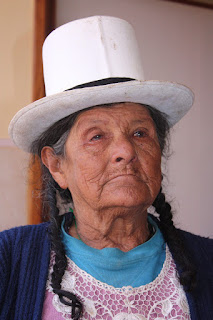 |
| photo by Alison Nichol |
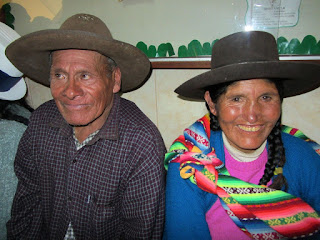 |
| photo by Marie Hasnain |
 |
| Marie with patients. photo by Alison Nichol |
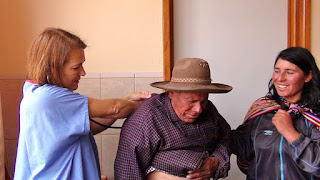 |
| Dr. Rosa with patient. photo by Claudia Paya |
Again, the majority of the patients we saw complained of chronic musculoskeletal pain and gastritis and we saw many serious eye problems. It seems that life is so hard for many of the people here that their bodies deteriorate dramatically after age 40 . . . and they still have to work until the day they die. It took my aunt Katherine and I the longest to get through our list of patients and when we emerged from the examination room the others were already waiting for the bus. We will be leaving whatever leftovers remain in the pharmacy for the nuns to incorporate at the Policlinico when we are gone.
I was pleased to see that the vitamins I brought from Napa Whole Foods were among the most requested by patients at the clinic, ordered in nearly every prescription that came through the pharmacy, and entirely cleared out by the time we left.
Though our time in the clinic is past, our work is not done:
 |
| Re-packing Party! photo by Claudia Paya |
Back at the Piccolo Locanda a while later the group gathered in the large central room of the hotel for a "repacking party." All the remaining suitcases (probably around 30-40) will be coming with us tomorrow as donations for the smaller villages we will be visiting outside Cusco. In a cloud of activity we organized all the childrens/womens/mens clothes and separated hygiene products from toys and school supplies . . . it was an utter explosion. And yet, as in every other moment of this trip I am amazed at how efficiently a task gets done when so many hands work together. Each person in our group brings a unique set of skills and personality traits. We all mesh so well and have naturally found our places within this great team. We are beginning to feel like family, in all the best possible ways. Later at dinner we were sad to say our goodbyes to the two doctors from Lima, Oscar and Luisa. They have contributed so much and have been an important part of this extraordinary group of people.
 |
| The Family. photo by Claudia Paya |






